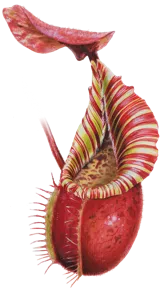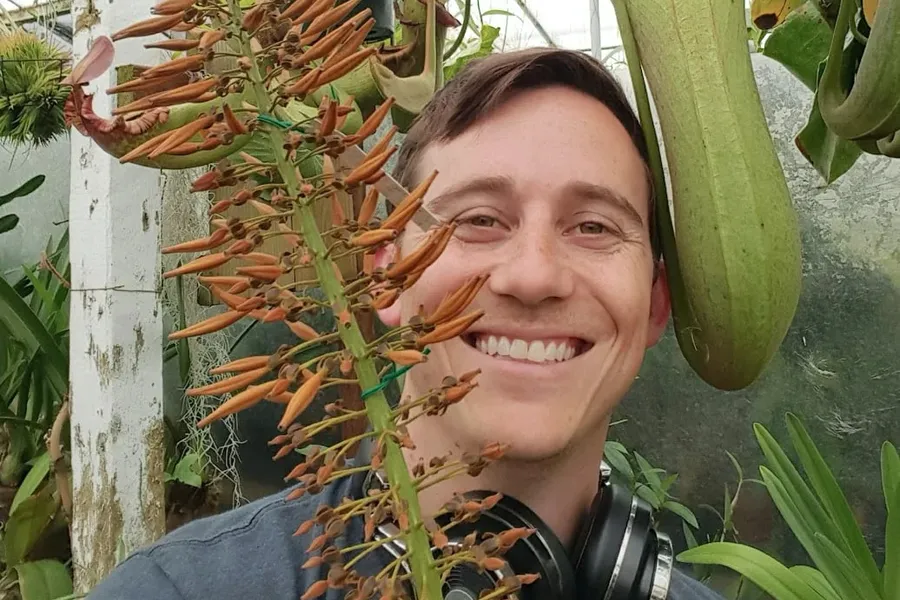Based in San Francisco in California, Predatory Plants is a carnivorous plant nursery owned and operated by Josh Brown. Last year they announced their internal Nepenthes hybridisation program, which has already brought a number of exciting new crosses to market.
I recently got the chance to speak to Josh about the program, its origins, and his advice for growers looking to get started with Nepenthes breeding. Read on!
First, could you introduce yourself and Predatory Plants?
My name is Josh Brown. I am a life-long carnivorous plant hobbyist and I started Predatory Plants in 2009. Since then Predatory Plants has grown to be one of the largest retailers of carnivorous plants in the United States.
For those who are new to hybridisation, could you explain how your grex-based system works?
The first thing to note is that our system is not officially sanctioned by any botanical organization. It is strictly an internal system that we use to organize our hybridization program. Formalizing the system was a collaborative effort between myself and Devon Peterson.
There’s nothing especially fancy about how we name the plants. For each male or female breeder in our greenhouse, we assign a name based on the first letter of that plant’s species or hybrid name (Nepenthes ventricosa = N. “Victory”, N. densiflora x spectabilis = N. “Dream”.) These names are then combined into memorable phrases when we make crosses (in this case, Nepenthes Dream of Victory.) This name is extremely information rich, since you can use it to learn exactly which parents were used to create a given cross.
Click on any photo to zoom in. Use arrow keys or swipe to navigate.
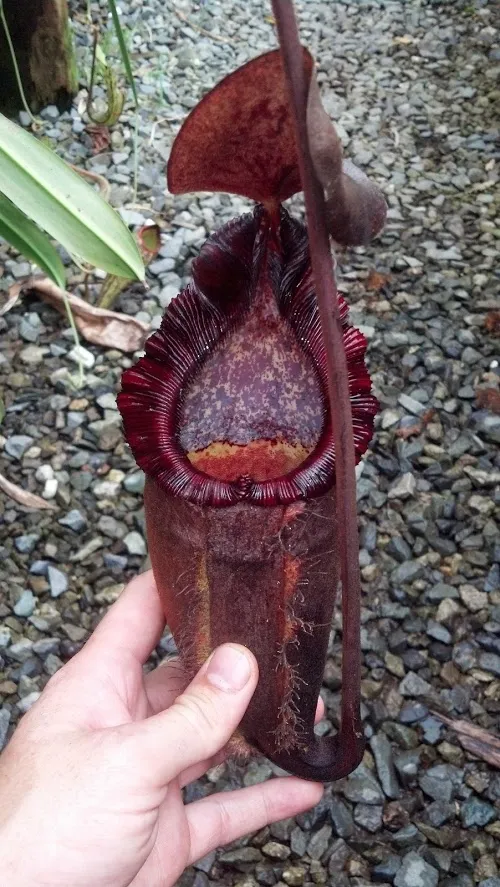 Nepenthes "Dream", which is a seed-grown N. densiflora x spectabilis "giant"
Nepenthes "Dream", which is a seed-grown N. densiflora x spectabilis "giant" .D-hdw48k_Z6wMd3.webp) Nepenthes ventricosa (with grex moniker N. 'Victory')
Nepenthes ventricosa (with grex moniker N. 'Victory') 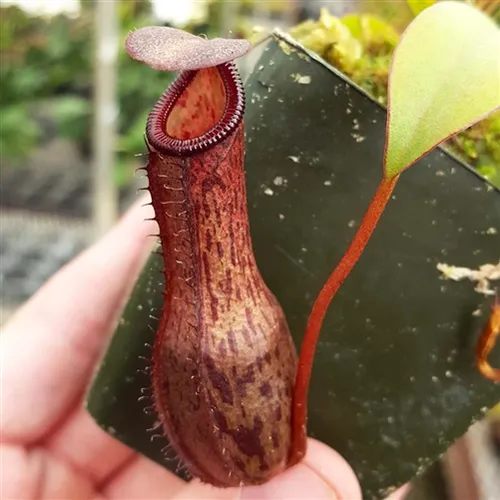 One of the darker N. "Dream of Victory" offspring
One of the darker N. "Dream of Victory" offspring 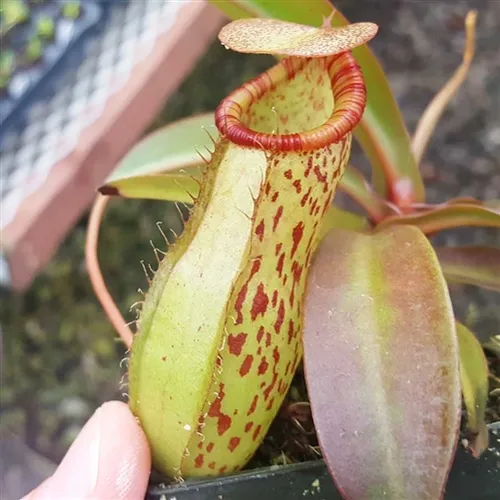 One of the lighter offspring of the N. "Dream of Victory" cross
One of the lighter offspring of the N. "Dream of Victory" cross The main reason we use this system is to shift the conversation away from focusing on which species are involved in a given hybrid (Nepenthes ventricosa, for example) and instead highlight the specific individuals that were used. Plant taxonomy is very dynamic. If someone comes along tomorrow and declares that the “red” form of Nepenthes ventricosa is now its own species, then everyone has to dig through their records and make changes (if they’ve even kept such records.) That’s not a problem for us, because the plant we call Nepenthes “Victory” will always have that name, regardless of how its standing as a species shifts over time.
How long have you been operating your grex program, and how many greges do you currently have for sale?
There are several possible answers to that question. I purchased the first plant that would eventually become one of my breeders (Nepenthes “Maiden” - N. maxima “dark”) in 1997, so you could say I’ve been working on it since then. However, that plant didn’t flower until 2014. That spike contained some of my first successful crosses, so that could also be considered the beginning of this breeding program. We didn’t formalize and publish our naming system until just last year (2016) so that’s the first time that anyone else was actually aware of the program.
As for the number of greges, we have sold individuals from about 15 different crosses since we began offering them for sale about 6 months ago.
How long does it take to bring a new grex to market? How many do you currently have in the pipeline, and can you share any details about them?
There is a bit of variation in how long it takes to grow Nepenthes from seed, but here’s our general expectations:
- 4-6 months of seed ripening after fertilization
- 2 months until we start to see germination of that seed
- 1 year until the largest plants are roughly dime-sized and ready for their first transplant
- 1 more year until the largest plants can be sold as typical “small” or “small/medium” size (size guide here)
- 1 more year until we start to see “medium” or “medium/large” plants
Click on any photo to zoom in. Use arrow keys or swipe to navigate.
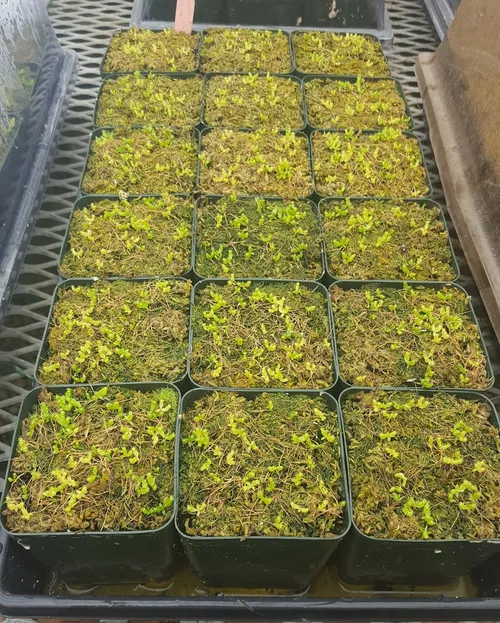 Germination of Nepenthes seeds at Predatory Plants.
Germination of Nepenthes seeds at Predatory Plants. .Pe-CL0Yk_ZgMWez.webp) Tray of 2-year-old Nepenthes Titan's Mirror (N. truncata x mira)
Tray of 2-year-old Nepenthes Titan's Mirror (N. truncata x mira) We currently have dozens of crosses going through the above pipeline, and that number is constantly increasing. Our breeding stock is very unique compared to the few other commercial Nepenthes hybridizers in the world, so there’s going to be a distinctly Predatory Plants “flavor” of hybrid once the program has been running for a few years.
What are some of the considerations when breeding Nepenthes specifically?
People need to understand that Nepenthes breeding is still in the “wild west” phase. There are very few established breeders out there, and there’s very little reliable information on the process.
It seems clear that pretty much all Nepenthes are cross-fertile to at least some extent. However, we’ve seen evidence that suggests that some crosses are much more successful than others.
Once you’ve created seed, you need to be careful about the conditions you provide seedlings. They tend to respond well to slightly warmer and more humid conditions than their parents while they are getting started.
In your experience, are certain characteristics skewed towards male or female parents?
I haven’t observed any specific evidence of male or female dominance in hybrids (this is the idea that the female or male parent has a greater impact on the traits of the offspring.) However, I certainly haven’t done enough research to rule this out.
What can be expected when the parent plants are extremely different from one another, whether morphologically or in terms of habitat?
While we’re still in the early days of Nepenthes hybridization, there are certainly some emerging patterns. Some plants have absolutely overpowering genetics (N. aristolochioides is a great example) while others seem to be much more “passive” in what traits they pass on.
Click on any photo to zoom in. Use arrow keys or swipe to navigate.
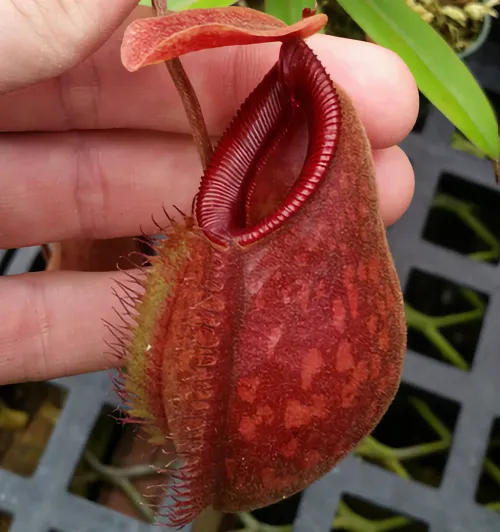 The pronounced influence of Nepenthes aristolochioides, this is N. aristolochioides x hamata.
The pronounced influence of Nepenthes aristolochioides, this is N. aristolochioides x hamata. 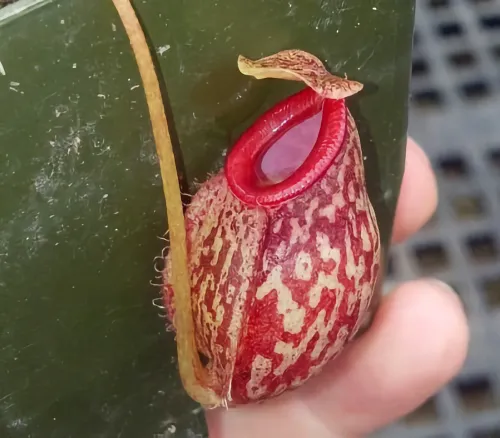 This is Nepenthes aristolochioides x glabrata.
This is Nepenthes aristolochioides x glabrata. People’s imaginations tend to run wild when thinking about potential crosses. They often think that ultra-complex crosses with all of the “best” plants will lead to some kind of super-plant. However, it seems to usually result in an highly variable seed-set with the majority of plants looking like extremely “average” Nepenthes.
What are some of your favourite breeders at Predatory Plants, and what favourable characteristics do they tend to pass on to their offspring?
Our current superstar is Nepenthes “Titan”. It’s an enormous female Nepenthes truncata that has been an absolute workhorse over the past few years. It flowers almost constantly with hundreds of flowers per spike, is extremely receptive to a wide range of pollen, and produces incredibly viable and vigorous seed. The offspring of this plant have been growing extremely well in both highland and lowland conditions, and are outpacing our most aggressive growth-rate estimates.
Another breeder that I’m personally fond of is Nepenthes “Lust”. It’s a male N. lavicola that I have managed to cross with a few interesting females so far. It’s an extremely uncommon plant, and I’m not aware of any hybrids ever being made with it. My hope is that it will act like a miniature Nepenthes spectabilis, which could lead to some beautiful, yet compact plants.
Click on any photo to zoom in. Use arrow keys or swipe to navigate.
.JEBR6BV4_1dCEW0.webp) N. Titan pitcher (Nepenthes truncata)
N. Titan pitcher (Nepenthes truncata) 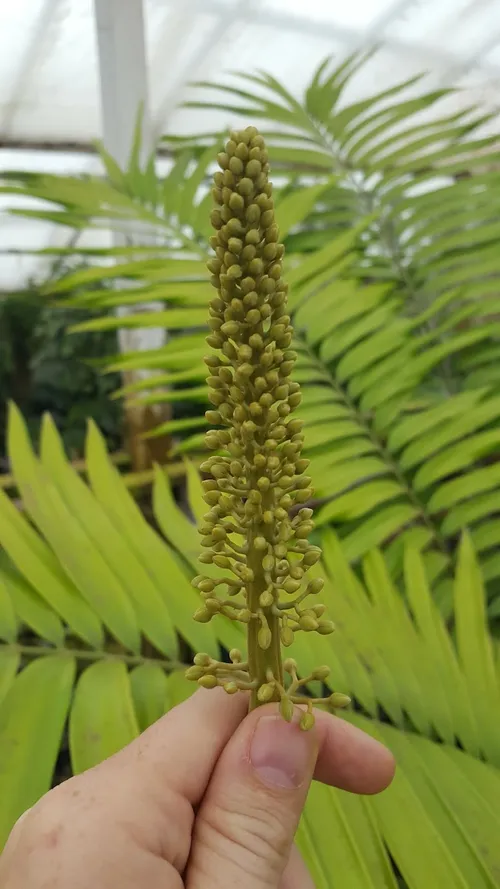 N. Titan, flowering female
N. Titan, flowering female 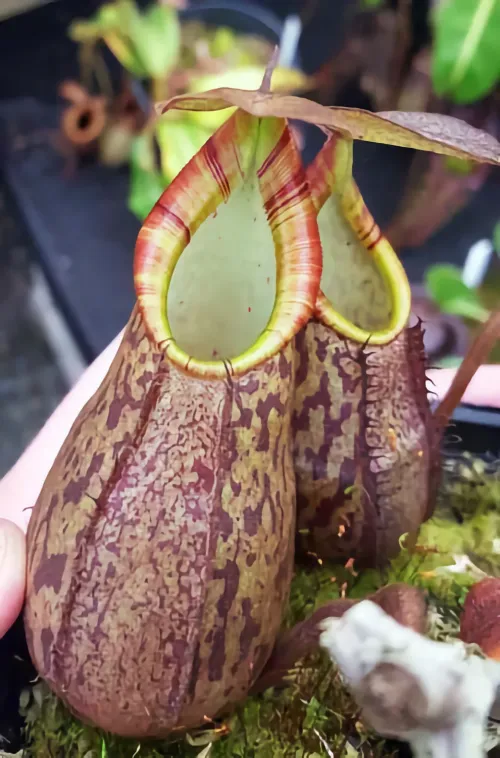 The male parent N. Lust, a Nepenthes lavicola.
The male parent N. Lust, a Nepenthes lavicola. 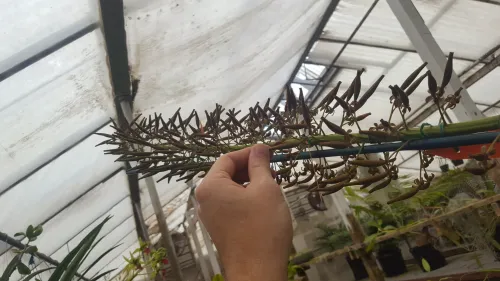 The spike on Nepenthes Titan, with developing seed pods.
The spike on Nepenthes Titan, with developing seed pods. One of the biggest surprises in our stable is Nepenthes “Dream”, which is a seed-grown N. densiflora x spectabilis “giant” that was part of a very small release from Borneo Exotics several years ago. The offspring from N. “Dream” have been reliably delightful, with good color, some nice striping, and a very unusual purplish foliage that occurs on about half of the seedlings. We’re really looking forward to more breeding with N. “Dream”.
What would be your tips for Nepenthes growers who are interested in experimenting with hybridisation for themselves?
We recently published a comprehensive video guide to growing Nepenthes from seed:
Our hope is that this video demystifies the whole process, and allows people to make the jump into doing this themselves.
Some other tips are:
- Label everything! The date the flower appeared, the date you applied pollen, the pollen parent, when you harvested, how the seed looked, when it started to germinate, etc. It is all valuable information. You’re going to wish you remembered to do it years later, so just start now.
- Don’t be afraid to trade your pollen/flowers with other hobbyists. Most new growers are unlikely to see more than one flower in their collection at any given time, let alone a wide enough variety of males and females to reliably produce interesting plants.
- Be patient. These things take a lot of time, and you’re probably going to have a lot of failures before you have anything to show for your efforts. Once you get the hang of it though, it’s incredibly satisfying!
Click on any photo to zoom in. Use arrow keys or swipe to navigate.
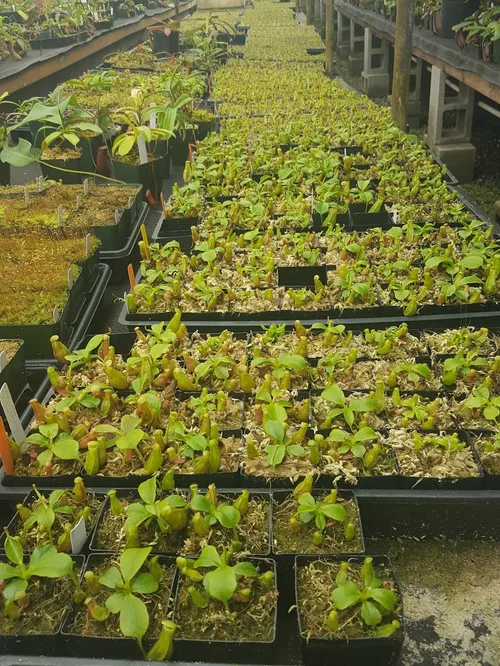 Hundreds of Nepenthes seedlings at the Predatory Plants greenhouses!
Hundreds of Nepenthes seedlings at the Predatory Plants greenhouses! 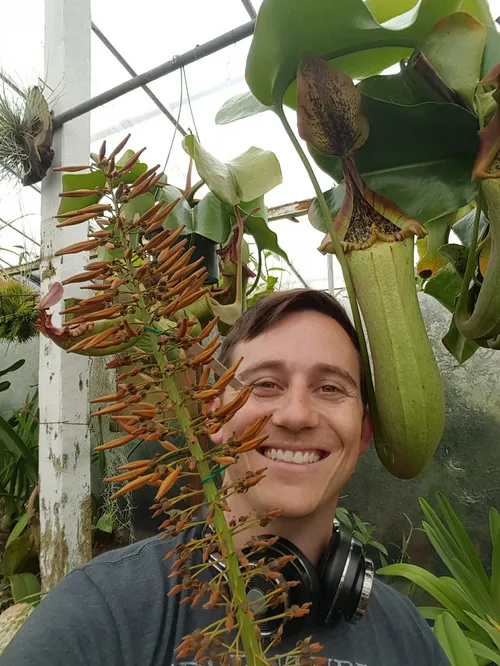 Josh with a Nepenthes truncata.
Josh with a Nepenthes truncata. Many thanks to Josh Brown, Devon Peterson, and the team at Predatory Plants. Check out their Nepenthes greges and follow them on Instagram.
If you’re interested in Nepenthes hybridisation, check out my hybrid calculator.
